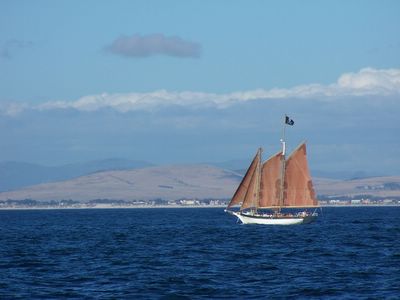
I took this picture of a "pirate ship" while holidaying in Cape Town, South Africa. We went on a sailboat ride and I saw this ship in the distance. Booking a ride on this "pirate ship" costs about $40.

I love taking photographs. It is a passion of mine. Though not a professional photographer, I like to always try and improve on my photographic skills.


At 1728 pixels vertical image size we get:
Normal:
------
Wide Angle:
f = 38 mm effective/6.32 mm
Closest distance: (which camera can focus)
d = 23.6 cm (from front of camera)
h = 180 mm (96 pixels/cm)
Farthest distance:
d = Infinite
1/3 from Wide Angle (approx):
f = 139 mm eff
Closest distance:
d = 44 cm
h = 102 mm (169 pixels/cm)
Farthest distance:
d = Infinite
2/3 from Wide Angle(approx):
f = 268 mm eff
Closest distance:
d = 103 cm
h = 118 mm (146 pixels/cm)
Farthest distance:
d = Infinite
Telephoto:
f = 380 mm effective
Closest distance:
d = 121 cm
h = 112 mm (154 pixels/cm)
Farthest distance:
d = Infinite
Macro:
------
Wide Angle:
f = 38 mm effective/6.32 mm
Closest distance: (which camera can focus)
d = 4.5 cm
h = 51 mm (339 pixels/cm)
Not Farthest distance:
d = 151cm
h = 1047 mm (17 pixels/cm)
Farthest distance: ??
d = 8.3 m
h = 5.6 m (3 pixels/cm)
1/3 from Wide Angle(approx):
f = 139 mm eff
Closest distance:
d = 38 cm
h = 89 mm (194 pixels/cm)
Not Farthest distance:
d = 155 cm
h = 306 mm (57 pixels/cm)
1/2 from Wide Angle(approx):
f = 209 mm eff
Closest distance:
d = 65 cm
h = 99 mm (175 pixels/cm)
Not Farthest distance:
d = 155 cm
h = 216 mm (80 pixels/cm)
2/3 from Wide Angle(approx):
f = 268 mm eff
Closest distance:
d = 78 cm
h = 91 mm (190 pixels/cm)
Not Farthest distance:
d = 167 cm
h = 177 mm (98 pixels/cm)
Telephoto:
f = 380 mm effective
Closest distance:
d = 79 cm
h = 78 mm (222 pixels/cm)
Not Farthest distance:
d = 167 cm
h = 148 mm (117 pixels/cm)
Farthest distance:
d = 175 cm
h = 109 mm (159 pixels/cm)
Here follows a summary of the above info:
----------------------------------------
where d=distance to subject from front of lens
Normal:
------
f = 38 mm eff
Closest distance: d = 23.6 cm (96 pixels/cm) 18 cm subject
Farthest distance:d = Infinite (<0 pixels/cm)
f = 139 mm eff
Closest distance: d = 44 cm (169 pixels/cm) 10.2 cm subject
Farthest distance:d = Infinite (<0 pixels/cm)
f = 268 mm eff
Closest distance: d = 103 cm (146 pixels/cm) 11.8 cm subject
Farthest distance:d = Infinite (<0 pixels/cm)
f = 380 mm eff
Closest distance: d = 121 cm (154 pixels/cm) 11.2 cm subject
Farthest distance:d = Infinite (<0 pixels/cm)
Macro:
------
f = 38 mm eff
Closest distance: d = 4.5 cm (339 pixels/cm) 5.1 cm subject
Not Farthest : d = 151 cm (17 pixels/cm) 104.7cm subject
Farthest : d = 8.3 m (3 pixels/cm) 560 cm subject
f = 139 mm eff
Closest distance: d = 38 cm (194 pixels/cm) 8.9 cm subject
Not Farthest : d = 155 cm (57 pixels/cm) 30.6 cm subject
f = 209 mm eff
Closest distance: d = 65 cm (175 pixels/cm) 9.9 cm subject
Not Farthest : d = 155 cm (80 pixels/cm) 21.6 cm subject
f = 268 mm eff
Closest distance: d = 78 cm (190 pixels/cm) 9.1 cm subject
Not Farthest : d = 167 cm (98 pixels/cm) 17.7 cm subject
f = 380 mm eff
Closest distance: d = 79 cm (222 pixels/cm) 7.8 cm subject
Not Farthest : d = 167 cm (117 pixels/cm) 14.8 cm subject
Farthest distance:d = 175 cm (159 pixels/cm) 10.9 cm subject
Reverse info:
s = Subject size to fill height of photo
d = distance from front of lens
f = focal length (effective)
s d f Macro
--- --- --- -----
5.1cm 4.5cm 38 mm yes wide
7.8cm 79cm 380mm yes tele
8.9cm 38cm 139mm yes 1/3
9.1cm 78cm 268mm yes 2/3
9.9cm 65cm 209mm yes 1/2
10.2cm 44cm 139mm no 1/3
10.9cm 175cm 380mm yes tele
11.2cm 121cm 380mm no tele
11.8cm 103cm 268mm no 2/3
14.8cm 167cm 380mm yes tele
17.7cm 167cm 268mm yes 2/3
18 cm 23.6cm 38mm no wide
21.6cm 155cm 209mm yes 1/2
30.6cm 155cm 139mm yes 1/3
104.7cm 151cm 38mm yes wide
560 cm 8.3m 38mm yes wide
It is supposed to be governed by the formula:
(but this approximation does not hold for multiple lens elements)
f = v * d / h
where v is the vertical size of the image on the CCD
h is the vertical field of view in the subject plane
d is the distance from the (thin lens approximation) lens element
f is the (thin lens aproximation) 35mm effctive focal length
I have been able to figure out that the DX6490 has the following:
Focal Length Multiplier = FLM = 380/63.2 = 38/6.32 = 6.01266...
and
FLM = 43.3mm (diagonal) / sensor diag = 6.01266
where 43.3 mm is the size of 35mm film
This means that the DX6490 must have a
Sensor diag = 7.201471 mm
this means that:
x^2 + y^2 = 7.201471^2
with an aspect ratio of: 4/3
x = (4/3)y
Solving the equations gives:
y = 4.32088 mm
x = 5.761177 mm
for the sensor.
This will result in a physical resoltion for the CCD sensor of:
x res = 2304/5.761177 = 400 pixels/mm
y res = 1728/4.32088 = 400 pixels/mm
The Kodak DX6490 therefore has a CCD image resolution of 400 pixels per millimeter or
400 x 400 = 160 000 pixels per square millimeter.
I have also determined that if the 2.2 inch LCD (which is actually 2.165 inch) has 153000 pixels, then 153000/(4/3) = y^2
y=338 pixels
x=451 pixels
451 x 338 pixels
I hope this helps someone out there. Please give me some comments.



